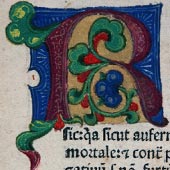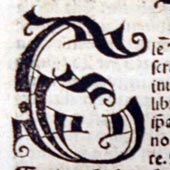Cabinet 04: Transition to Printing Presses

The splendour and glory of the illuminated initial in Western Europe was all but over by the Gothic period (late 1400s - early 1500s). Although they were no longer "a visual expression of the Word of God" (Nesbitt), ornate initials retained their place as decorative components of texts. Incunabula printers incorporated manuscript initials into their productions, by leaving a space for illuminators to add initials after the text was printed. The illuminated initial in Franciscus de Platea’s Opus restituionum is a wonderful example of this blending of the traditional art of decorative initials with the new printing press technology.
Franciscus de Platea, [Opus restitutionum usurarum et excommunicationum] Incipit op[us] restitutionu[m] vtilissimu[m] a reuere[n]doin Christo patre fratre Fra[n]cisco de platea bononie[n]se ordinis mino[rum] diuiniq[ue] vbi predicatore eximio editum. Venetiis : Johannes de Colonia and Johannes Manthen, 1474. DeBeer Itb 1474 P

Although space was left for initials to be added, this did not always happen, as seen here in Nicolas d’Orbelles’s Expositio logicae. A number of reasons could account for such an omission, including the difficulty of finding skilled illuminators. Printing presses produced texts in greater quantities than scribes of traditional manuscript texts. Rowan Watson speculates that manuals, like the Göttingen Model Book (c.1460), were created to address the instructional needs of untrained illuminators employed to keep pace with the press productions.
Nicolas d'Orbelles, Expositio logicae. Parma, Damianus de Moyllis and Johannes Antonius de Montalli, Apr. 30 (die ultimo Mensis Aprilis), 1482. Shoults

As printers took over all aspects of text production, the art of traditional illuminated initials died out. Printers, however, maintained the essence of the illuminated initial by creating and inserting in its place an enlarged, and often decorative, form of an initial letter. Made firstly from woodcuts, and later from metal-cuts, copper engravings and etching, these printed initials were originally designed to imitate manuscript initials. As techniques developed and fashions changed, so too did the design of printed initials. Summula clarissimi contains an example of a Gothic calligraphic printed initial.

